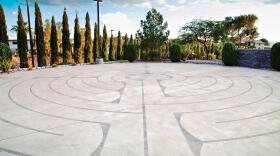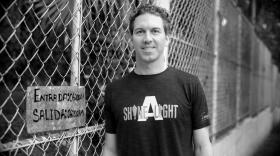Mitch Hanson and Amy Pienta SOMERSAULT LETTERPRESS
When you ask Mitch Hanson what makes letterpress printing so special, he answers by handing you his business card. Then you get it. “You feel that? It’s tactile. It’s dimensional. There’s substance,” he says. “When I hand people our card, they understand. ‘This is cool. They spent some money and time on this.’” And love. In an age of iPads, Evites and cheap laser printers, Somersault Letterpress is a enthusiastic throwback that serves up slow-cooked print amid a sea of digital fast food, from wedding invitations to menus — heck, even the promo pieces they’ve created for Strip megaresorts are achingly gorgeous. Meet the ink-stained duo: Mitch Hanson (printer) and Amy Pienta (designer) launched Somersault Letterpress (somersaultletterpress.com) in June 2011, long suspicious that reports of print’s death were greatly exaggerated. “A book is a book and paper is paper, and nothing will ever change that,” Pienta declares. She even got the blessing of her parents — sort of. When she told her father, a former printer, she was planning to start a letterpress company, he balked: “He says, ‘Those guys are all drunks with missing fingers! Why would you do that?’” Thus far, no missing fingers, but a growing clientele of people who want something more than a Facebook post or email blast to announce a special event. What is letterpress, anyway? It’s a craft method of machine printing that plays in three dimensions: Think raised letters, embossed logos, custom cuts and foils. The result is simultaneously crisp, clean, lush and luxurious — which also describes Pienta’s design work. Now meet the machines behind the people. There’s Peanut, a Chandler & Price American letterpress, a veritable steel tank bristling with flywheels and levers. When Hanson fires it up, it chugs along with a viscerally satisfying ka-choom ka-choom ka-choom. And then there’s Eva, a 1957 Heidelberg Windmill, a German machine the size of a small fridge; watching the slender arms feed paper and retrieve fresh prints is mesmerizing. Oh, and the sound. The throaty chutter of the Heidelberg’s crank raising the feed table is sooo steampunk. “It always reminds me of the sound when the rollercoaster is going up the first hill,” says Pienta. (She can’t help but shout, “Ladies and gentlemen, make sure your arms and legs are safely in the car!” when she hears Hanson turn the crank.) And soon to join the crew: A Kelsey Excelsior handpress, a stout tabletop model. “This is what Ben Franklin used,” Hanson says with fatherly affection. Indeed, it wouldn’t be surprising if the Kelsey did duty printing pamphlets during the Revolutionary War. “These things never break down,” says Hanson (knock on steel). “They require a lot of lubrication, but these were built to last.” Not unlike their print work. One perk of being friends with Hanson and Pienta? You’ll get one hell of a custom birthday card. Case in point: Pienta recently designed a congratulations card for a bride-to-be friend. She designed the card, and Hanson was up half the night, making the plates, prepping the machine — for a press run of one.








